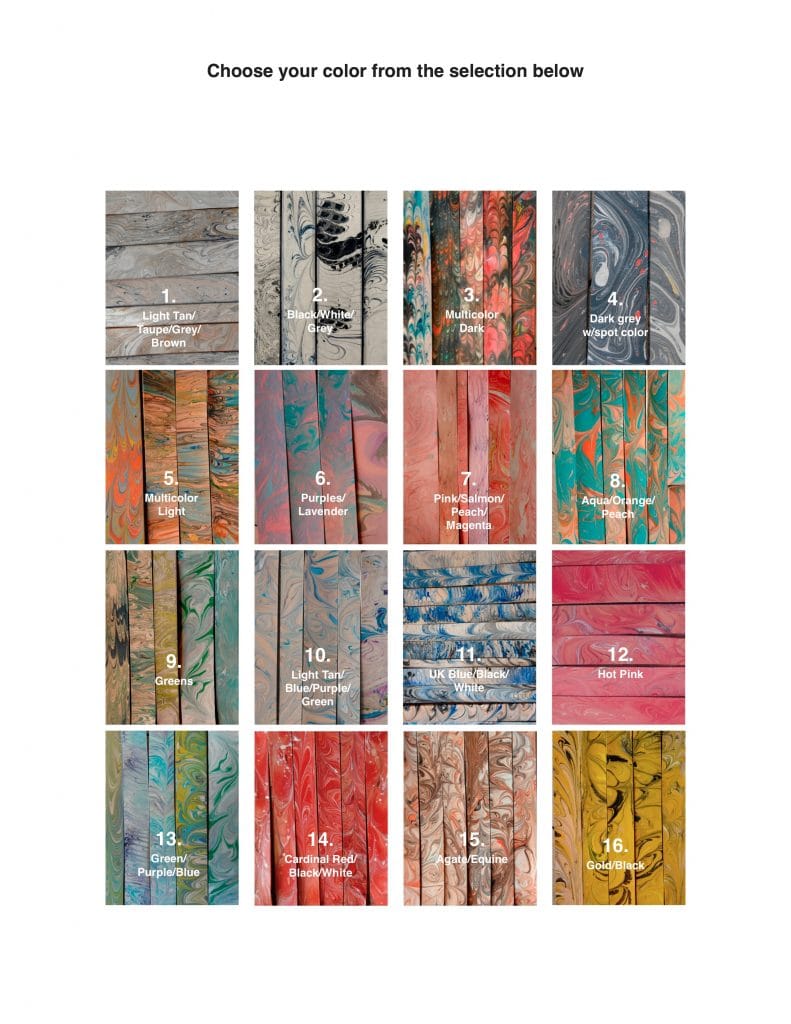What is Marbling?
Paper marbling is a method of aqueous surface design, which can produce patterns similar to smooth marble or other kinds of stone. The patterns are the result of color floated on either plain water or a viscous solution known as size, and then carefully transferred to an absorbent surface, such as paper or fabric. Through several centuries, people have applied marbled materials to a variety of surfaces. It is often employed as a writing surface for calligraphy, and especially book covers and endpapers in bookbinding and stationery. Part of its appeal is that each print is a unique monotype.
Marbling History
The art of marbling paper originated in Asia—with the Japanese art of Suminagashi and the Turkish Ebrû form—and eventually made its way toward Europe around the time of the Renaissance. From Europe, marbled papers would make their way across the Atlantic to reach American shores. The earliest examples of American marbling can be traced to the 1760s, but the art form did not become an industry until the first half of the nineteenth century.
In Japan, traditional paper marbling is known as suminagashi (“floating ink”), and the Turkish form is called ebru. In both techniques, inks are dropped into a shallow pan filled with water or size, where they float on the surface. Designs are added with a fan or by blowing gently. The paper is laid onto the ink for a brief time and then removed.
Marbling in Western Europe was similar, but since inks and paints in Europe were water-based (sumi ink is not), another chemical was needed to thicken the water so the paints would not sink. Another difference was the process of coating the paper, which allowed the paper to be rinsed after and retain its marbled pattern. Styluses and combs of all kinds were used to create different effects in the patterns.
Early in its history, marbled paper was used for important documents. Marbling always creates a one-of-a-kind monograph. Even if the exact same process was used, variations in the water, the artist’s hand movements, even the dust particles in the air prevent an exact duplicate. As such, marbled paper was used to prevent forgeries and erasure. As the business of book binding took off, marbling was also used on the edges of ledgers, for book covers and end-papers, but also for lining chests, drawers, and bookshelves.
Marbling Today
Marbled paper is still made today, and the method is now applied to fabric and three-dimensional surfaces, as well as paper. Aside from continued traditional applications, artists now explore using the method as a kind of painting technique, and as an element in collage. In the last two decades, marbling has been the subject of international symposia and museum exhibitions.
My Passion, My Marbling…
Before a recent trip to Italy, I researched marbling workshops, as marbling in publishing originated in Florence, Italy in the 1600’s, and have always been mesmerized by the process. After purchasing some leather and returning home, I wondered if it was possible to marble on leather. After a good bit of research online, I could find nothing about marbling on leather. It was time to experiment and play – and after A LOT of trial and error – a process and passion was born, Marbl’d™ Leather!
Marbled Color Schemes


